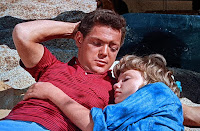In March of 1942, days after the Allied defeat at Corregidor, Lieutenant Commander Jeff Conway (Cliff Robertson, pictured at right) of the USS Dragonfish risks his submarine's safety to pick up a couple of battle survivors on a raft, an act that, though successful, doesn't sit well with his superior officers. His next assignment is to keep track of several Japanese ships which appear to be converging on New Guinea where a naval victory would assure the Japanese of dominance over the Coral Sea and put Australia at risk. He is told that, if need be, he should be prepared to scuttle the sub and sacrifice his men to stop the enemy from getting ahold of his orders. Lt. Len Ross has jerry-rigged a camera so he can take pictures through the ship's periscope and things are going well until they get caught in a minefield and the Japanese attach depth charges to the ship. Conway burns his orders and shoots the photographs out into the sea depths, then he and the crew surrender. They wind up on a POW camp island where the overseer, Commander Mori, is proud of being civilized (even though he overworks Ross, who has pneumonia) and he refuses to use torture to get Conway to spill the beans on his mission. The Americans get friendly with two British POWs (Patricia Cutts and Robin Hughes), and all are a little less friendly to Karen Philips (Gia Scala), a translator working for Mori while claiming to be neutral. Conway figures they can hold out until May 4th, by which time the Allies will already have met to begin an offensive attack, but when Mori admits that his more passive attempts to get information have failed, a new commander is called in who is anxious to use torture and death to get what he wants. Karen finally takes sides with the Allies, and soon they are executing a plan to escape by fashioning bows and arrows, and hijacking a Japanese ship.
The title of this film is misleading in a couple of ways: 1) this is not a war action movie, so don't expect the usual genre scenes of combat; 2) there was a real Coral Sea battle, but we don't see it in the movie until the final few minutes when it is recreated via newsreel footage and miniatures. I enjoyed the movie for what it is, essentially a POW camp escape story (with a slight, if less slapstick, Hogan's Heroes aura). Cliff Robertson is convincingly commanding and stoic while playing down any macho bluster. Gia Scala is quite good as the translator; occasionally she reminded me of Ingrid Bergman, especially around her eyes. Hughes and Cutts are fine, and Gordon Jones (as a beefy torpedoman) and Gene Blakely (as Lt. Ross) provide good support. It's a bit of a slow burn for action fans, but the escape and final battle are fairly satisfying. [TCM]












